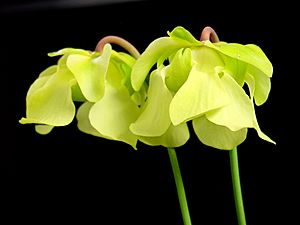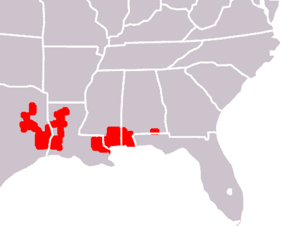Yellow trumpets facts for kids
Quick facts for kids Yellow trumpets |
|
|---|---|
 |
|
| Sarracenia alata flowers | |
| Conservation status | |
| Scientific classification | |
| Genus: |
Sarracenia
|
| Species: |
alata
|
 |
|
| Sarracenia alata range | |
| Synonyms | |
|
|
The Sarracenia alata, also known as the yellow trumpets or pale pitcher plant, is a fascinating carnivorous plant. This plant belongs to the Sarracenia genus and is naturally found in North America. It gets its name from its unique pitcher-shaped leaves that trap insects.
Contents
Where Does the Pale Pitcher Plant Live?
Like all plants in the Sarracenia group, the pale pitcher plant grows in the New World. It loves places that are always wet and open. You can often find it in wetlands called longleaf pine savannas. These areas are home to tall pine trees.
The Sarracenia alata's home is split into two main areas. One area stretches from eastern Louisiana, across southern Mississippi, and into western Alabama. The other area is in eastern Texas and western Louisiana. In Mississippi, you can find huge groups of these plants. They are as big as any other Sarracenia species!
What Does Sarracenia alata Look Like?
The flowers of the Sarracenia alata are very colorful. They can be cream, white, green, yellow, or even reddish! These different colors can be found in plants that grow hundreds of miles apart. This means the colors are natural and not from mixing with other Sarracenia plants.
The Sarracenia alata is quite similar to another plant called Sarracenia rubra. However, there are a few small differences. The Sarracenia rubra usually has more net-like patterns on its pitchers. The Sarracenia alata often has more of a pinstripe pattern. Also, the pitchers of the Sarracenia alata tend to grow taller.
Images for kids
See also
 In Spanish: Sarracenia alata para niños
In Spanish: Sarracenia alata para niños




